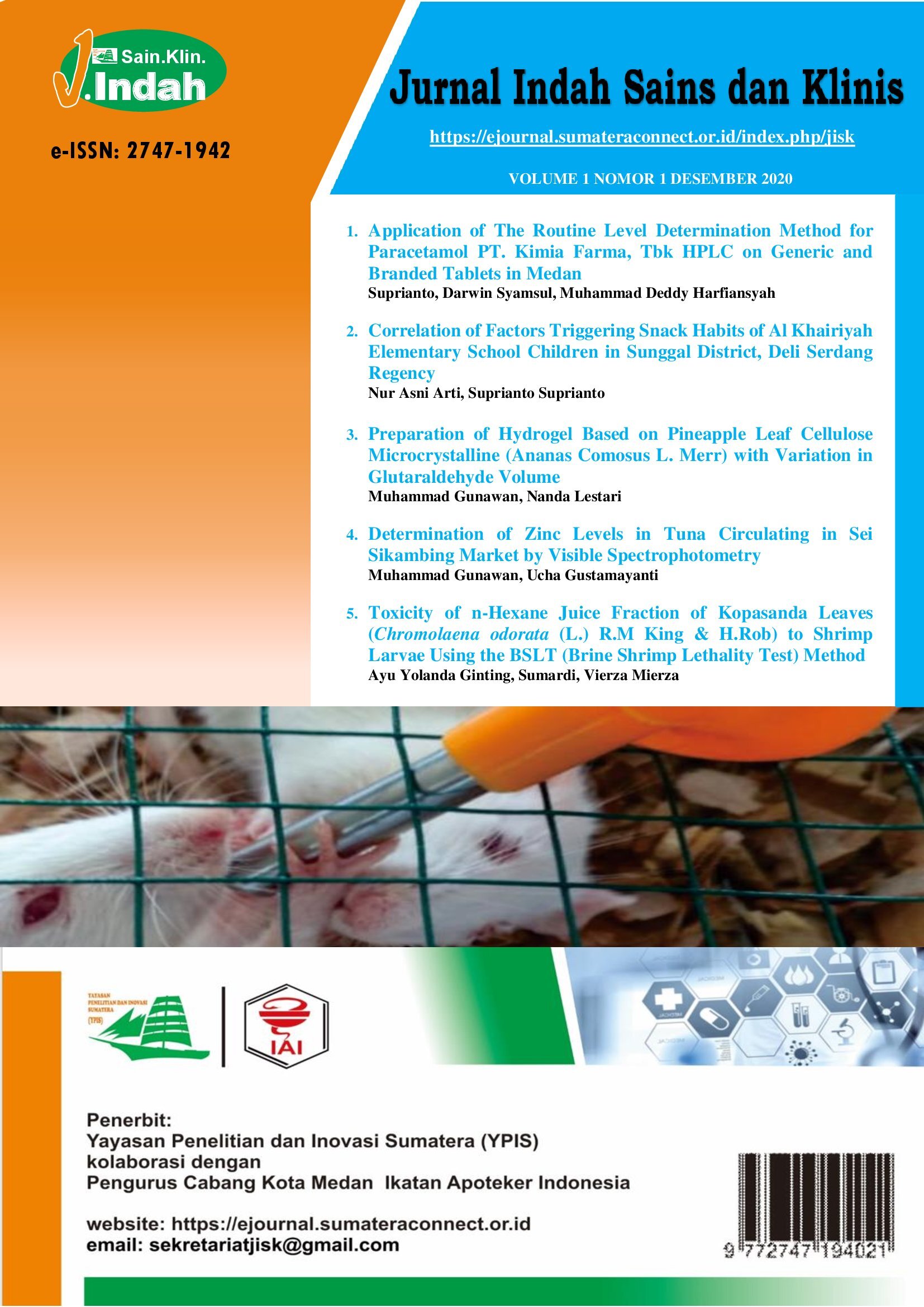Preparation of Hydrogel Based on Pineapple Leaf Cellulose Microcrystalline (Ananas Comosus L. Merr) with Variation in Glutaraldehyde Volume
DOI:
https://doi.org/10.52622/jisk.v1i1.3Keywords:
Pineapple leaves, cellulose microcrystals, cellulose hydrogelAbstract
Pineapple leaves natural fibers contain lignin, hemicellulose, and cellulose. The cellulose content of pineapple leaves is around 69.5% -71.5%. Cellulose-derived microcrystals can be used in the pharmaceutical field as binders in tableting formulations. The research objective was to determine whether pineapple leaves can produce microcrystals, microcrystals can be used in the manufacture of hydrogels and to determine variations in the volume of glutaraldehyde that can affect hydrogels. Experimetal researchbegan with delignification with 4% NaOH, immersed for 1 hour and heated, washed with distilled water until neutral pH and blended with 2.7% NaOH, 7.9% acetic acid, NaOCl until white, heated, the residue was taken and drained. , soaked in 1 N HCl, reheatedfor 2 hours, re-stirred and blended until smooth. Cellulose hydrogel was dissolved in 8.5% NaOH and added with glutaraldehyde in various volume variations. Cellulose and hydrogel microcrystals were characterized by visual, swelling ratio test, FTIR, SEM and XRD. The yield of microcrystalline cellulose was 22%, white, homogeneous. Cellulose and hydrogel microcrystals contain O-H (3800-2700 cm-1), C-H (3000-2850 cm-1) and C-O (1300-800 cm-1) groups. Microcrystalline cellulose can be made from pineapple leaves, hydrogel formation is influenced by variations in the volume of glutaradehydeand the highest and lowest swelling ratios are 400% and 12.5%, respectively.
Downloads
References
Azubuike, Chukwuemeka P, and Augustine O Okhamafe. 2012. “Physicochemical, Spectroscopic and Thermal Properties of Microcrystalline Cellulose Derived from Corn Cobs.” International Journal of Recycling of Organic Waste in Agriculture1 (1): 9. https://doi.org/10.1186/2251-7715-1-9.
Erizal, Erizal. 2010. “The Effect of Hydrogel Dressing Copolymer Poli(Vinylpirolidone) (PVP) -K-Carrageenan Prepared by Radiation and Healing Times on The Radius Reductions Burn Injuried of Wistar White Rat.” Indonesian Journal of Chemistry8 (2): 271–78. https://doi.org/10.22146/ijc.21633.
Hidayat, Pratikno. 2008. “Teknologi Pemanfaatan Serat Daun Nanas Sebagai Alternatif Bahan Baku Tekstil.” Teknoin13 (2): 31–35. https://doi.org/10.20885/teknoin.vol13.iss2.art7.
Karbelani, Luthfi. 2014. “Prarancangan Pabrik Microcrystalline Cellulose Kapasitas Lima Ribu Ton Per Tahun.” Skripsi, Universitas Gadjah Mada.
Purba, Marlina. 2015. “Pembuatan Hidrogel Berbasis Selulosa Dari Tongkol Jagung (Zea Mays L) Dengan Metode Ikat Silang.” Skripsi, Universitas Sumatera Utara
Downloads
Published
Issue
Section
License
Copyright (c) 2024 Jurnal Indah Sains dan Klinis

This work is licensed under a Creative Commons Attribution-NonCommercial-ShareAlike 4.0 International License.









 This work is licensed under a
This work is licensed under a 
